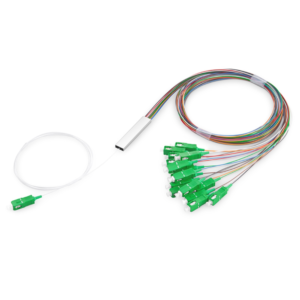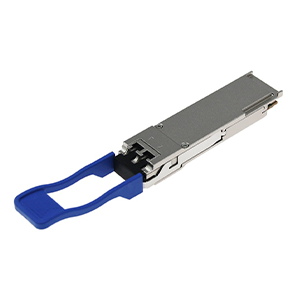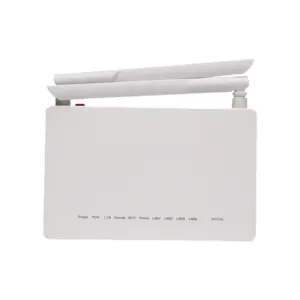Fiber splitters play an important role in optical communication networks. This article will focus on the characteristics of 1×8 PLC fiber splitters. We will first define the basic structure and working principle of 1×8 PLC fiber splitters and explain how they differ from other optical splitters.
Next, we will analyze the main features of 1×8 PLC fiber splitters, including high splitting ratio, miniaturized design, low loss, excellent optical properties, and high reliability. We will explain how these features improve the performance of optical communication systems. Subsequently, we will analyze the use of 1×8 PLC fiber splitters in typical application scenarios such as access networks and data centers, and explain their key role in each application.
What is 1×8 PLC fiber splitter
Let me introduce you in detail the basic definition and working principle of 1×8 PLC fiber splitter, as well as the difference from other optical splitters:
Definition of 1×8 PLC fiber splitter:
- PLC (Planar Lightwave Circuit) splitter is an optical splitter based on planar optical waveguide technology
- 1×8 PLC splitter refers to a PLC splitter with 1 input port and 8 output ports
- It uses a specially designed planar optical waveguide structure to split and distribute optical signals
1×8 Working principle of PLC fiber splitter:
- The optical signal at the input end will pass through the optical waveguide splitting structure inside the PLC splitter
- This structure can gradually split a single input light into 8 output optical signals
- This splitting process is achieved through optical components such as optical waveguide couplers
- Finally, the optical power of the 8 output lights is roughly equal
PLC splitter Differences from other optical splitters:
- Traditional optical fiber splitters are based on the structure of optical fiber fusion branching
- PLC splitters are integrated and manufactured using planar optical waveguide technology
- PLC splitters have the advantages of small size, simple manufacturing process, and low cost
- However, compared with optical fiber splitters, the optical loss of PLC splitters is increased
In short, 1×8 PLC optical fiber splitter is a unique optical splitter device based on planar optical waveguide integration. It can efficiently split a single input light into 8 outputs. It has obvious advantages in small size and low cost. It is an important optical splitter product widely used in the current optical communication field.
Main features of 1×8 PLC fiber splitter
Let me introduce you to the main features of 1×8 PLC fiber splitter in detail:
High split ratio:
- 1×8 PLC splitter can split 1 input optical signal into 8 outputs
- This 8-fold split ratio is one of its unique advantages
- High split ratio helps improve the signal utilization of the entire optical network
- It can make full use of limited light source resources and improve system efficiency
Miniature design:
- 1×8 The PLC splitter is manufactured using planar optical waveguide integration technology.
- Its overall size and weight are very small, and it has excellent integration.
- This compact and portable design is conducive to improving network deployment flexibility.
- It provides an ideal solution for optical access networks, data centers and other application scenarios.
Low loss:
- The optical signal attenuation of the 1×8 PLC splitter is usually less than 3.5dB.
- This excellent low loss performance retains the input optical power to the greatest extent.
- It helps to improve the transmission quality and reliability of the entire optical transmission system.
- It is the key to meet the signal quality requirements of high-speed optical communications.
Excellent optical properties:
- 1×8 PLC splitter has excellent optical indicators, such as insertion loss, uniformity, etc.
- These excellent optical parameters ensure the high quality of the output optical signal
- Provide strong guarantee for applications with strict requirements on optical signal quality
- Ensure the stable and efficient operation of the entire optical communication system
High reliability:
- 1×8 PLC splitter adopts mature planar optical waveguide manufacturing process
- It has good environmental interference resistance and long-term stability
- These characteristics help to improve the reliability and service life of the entire optical system
- Greatly enhance the system’s risk resistance and operational stability
In short, 1×8 PLC fiber splitter plays a key role in various optical network applications with its outstanding features such as high splitting ratio, miniaturized design, low loss, excellent optical performance and high reliability.
1×8 PLC fiber splitter application scenario introduction
Let me introduce you to the use of 1×8 PLC fiber splitter in typical application scenarios:
Optical access network application:
- 1×8 PLC splitter is widely used in the equipment deployment of optical fiber access network
- Single optical fiber signal can be split to multiple user terminal devices
- This one-to-many splitting can greatly improve the utilization of optical fiber resources
- The compact design of 1×8 PLC splitter is conducive to the deployment and maintenance of access network
Data center application:
- In the optical interconnection network inside the data center, 1×8 PLC splitter plays an important role
- Single light source signal can be split to multiple servers or switches
- Improved the multiplexing degree of optical signals and optimized the allocation of optical fiber resources
- The low loss characteristics of 1×8 PLC splitter ensure the transmission quality of high-speed optical interconnection
Broadcasting and television network applications:
- 1×8 PLC splitter can be applied to optical fiber nodes of cable TV networks
- Distribute the central light source signal to multiple optical distribution nodes
- This one-to-many splitting helps to expand the coverage of TV signals
- The compact design of 1×8 PLC splitter simplifies node deployment
Test instrument application:
- 1×8 PLC splitters can be used for signal distribution of fiber optic test instruments.
- The test light source is divided into multiple outputs for use at different measurement points.
- This splitting design improves test efficiency and measurement accuracy.
- The excellent optical performance of the 1×8 PLC splitter ensures the reliability of the test.
In short, the 1×8 PLC fiber splitter is widely used in optical access networks, data centers, broadcasting and television networks, and test instruments due to its high splitting ratio, low loss, and miniaturized design. It plays a key role in these applications and provides strong support for the entire optical communication system.
Summary
The 1×8 PLC fiber splitter is a key component for building a high-performance optical communication network. Our company has long been focusing on the research and development and production of optical fiber communication technology and has rich experience in the application of 1×8 PLC fiber splitters. We provide various high-performance 1×8 PLC fiber splitter products to meet your needs in different fields such as access networks and data centers.
Our 1×8 PLC splitter adopts advanced manufacturing technology, has excellent optical performance, low loss and high reliability, and can effectively improve the quality and stability of network transmission. At the same time, our engineering team will provide you with professional selection guidance and integration services to ensure that the 1×8 PLC fiber splitter performs best in practical applications. Contact us now to learn more. We will do our best to provide you with the best quality products and solutions.
1×8 PLC Fiber Optic Oplitter FAQ
A 1×8 PLC (Planar Lightwave Circuit) fiber optic splitter is an optical device that splits a single input fiber into eight output fibers, used in fiber optic communication systems for signal distribution.
It uses a planar lightwave circuit technology to evenly distribute the light signal from one input fiber to eight output fibers, ensuring minimal signal loss and consistent performance.
It is commonly used in fiber-to-the-home (FTTH) networks, telecommunications, and data centers to distribute optical signals to multiple endpoints.
Key specifications include insertion loss, uniformity, wavelength range, and the size of the splitter package. Typical insertion loss ranges from 10 to 15 dB.
Insertion loss refers to the amount of signal power lost when the signal passes through the splitter. It is important because lower insertion loss means better signal strength and quality.
Compared to traditional fused biconic taper (FBT) splitters, PLC splitters offer better uniformity and lower insertion loss, making them suitable for applications requiring high performance and reliability.
Installation should be done with care to avoid bending or stressing the optical fibers. It is often housed in a compact module or tray to facilitate easy integration into network systems.
Yes, but it needs to be housed in an appropriate enclosure to protect it from environmental factors like moisture, dust, and extreme temperatures.
The cost varies depending on the manufacturer and specifications but typically ranges from $50 to $200.
Performance is tested using optical testing equipment to measure parameters such as insertion loss, splitting uniformity, and return loss. This ensures that the splitter meets the required performance standards.




